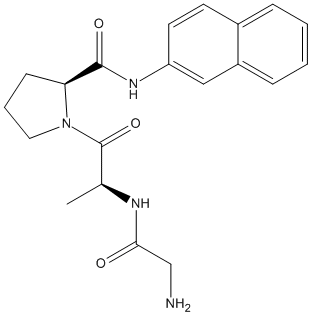DB07813
General
Type : Naphthylamide || Peptide || Pyrrolidine || Carboxamide || Naphthalen
Chemical_Nomenclature : (2S)-1-[(2S)-2-[(2-aminoacetyl)amino]propanoyl]-N-naphthalen-2-ylpyrrolidine-2-carboxamide
Canonical SMILES : CC(C(=O)N1CCCC1C(=O)NC2=CC3=CC=CC=C3C=C2)NC(=O)CN
InChI : InChI=1S\/C20H24N4O3\/c1-13(22-18(25)12-21)20(27)24-10-4-7-17(24)19(26)23-16-9-8-14-5-2-3-6-15(14)11-16\/h2-3,5-6,8-9,11,13,17H,4,7,10,12,21H2,1H3,(H,22,25)(H,23,26)\/t13-,17-\/m0\/s1
InChIKey : KCELZXZDIUJGNM-GUYCJALGSA-N
Other name(s) : glycyl-L-alanyl-N-naphthalen-2-yl-L-prolinamide
MW : 368.42
Formula : C20H24N4O3
CAS_number :
PubChem :
UniChem :
Iuphar :

Target
Families : DPP4N_Peptidase_S9
References (2)
| Title : Crystal structure and mechanism of tripeptidyl activity of prolyl tripeptidyl aminopeptidase from Porphyromonas gingivalis - Ito_2006_J.Mol.Biol_362_228 |
| Author(s) : Ito K , Nakajima Y , Xu Y , Yamada N , Onohara Y , Ito T , Matsubara F , Kabashima T , Nakayama K , Yoshimoto T |
| Ref : Journal of Molecular Biology , 362 :228 , 2006 |
| Abstract : Ito_2006_J.Mol.Biol_362_228 |
| ESTHER : Ito_2006_J.Mol.Biol_362_228 |
| PubMedSearch : Ito_2006_J.Mol.Biol_362_228 |
| PubMedID: 16914159 |
| Gene_locus related to this paper: porgi-q7muw6 |
| Title : Crystallization and preliminary X-ray characterization of prolyl tripeptidyl aminopeptidase from Porphyromonas gingivalis - Nakajima_2005_Acta.Crystallogr.Sect.F.Struct.Biol.Cryst.Commun_61_1046 |
| Author(s) : Nakajima Y , Ito K , Xu Y , Yamada N , Onohara Y , Ito T , Yoshimoto T |
| Ref : Acta Crystallographica Sect F Struct Biol Cryst Commun , 61 :1046 , 2005 |
| Abstract : Nakajima_2005_Acta.Crystallogr.Sect.F.Struct.Biol.Cryst.Commun_61_1046 |
| ESTHER : Nakajima_2005_Acta.Crystallogr.Sect.F.Struct.Biol.Cryst.Commun_61_1046 |
| PubMedSearch : Nakajima_2005_Acta.Crystallogr.Sect.F.Struct.Biol.Cryst.Commun_61_1046 |
| PubMedID: 16511231 |
| Gene_locus related to this paper: porgi-q7muw6 |